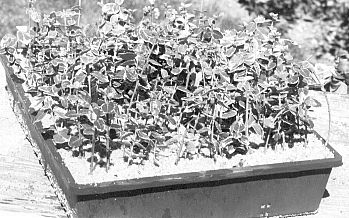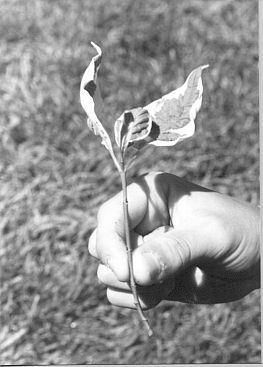If you’ve read our article on propagating hardwood cuttings of deciduous plants, you know it is also possible to propagate those plants using softwood cuttings. We are using Burning Bush, a popular deciduous landscape shrub, as an example to help you understand how to propagate softwood cuttings and what differentiates them from hardwood cuttings.

Softwood cuttings compared to hardwood cuttings
Plants grow quite a lot during the year. If you’ve never studied the development of Burning Bush buds, we recommend doing it – it’s fascinating. The tiny buds of the shrub quickly turn into 6 to 8-inch long shoots. That new growth is flexible and elastic-like at first but hardens over time, losing its flexibility. And by autumn, the once pliable shoots are fully rigid.
The main difference between softwood and hardwood cuttings is the time the cuttings are taken. And whether you are opting for the first or the latter, you should always take the cuttings from the current year’s plant growth. Just avoid delving too deeply into your plant to prevent taking cuttings from older growth. Unfortunately, propagation projects done with cuttings from growth older than a year rarely result in success.
While hardwood cuttings are taken during winter when the plants are dormant, softwood cuttings are taken during the warmer season of late spring/early summer. Generally, the cuttings are taken in late May or early June, depending on the climate in your area. We recommend waiting until the wood begins to harden to take softwood cuttings.
Another difference between softwood and hardwood cuttings is the time they require for growing roots. Softwood cuttings generally root very quickly if looked after properly. However, those cuttings are delicate, and because of that, they can be difficult to root. While rooting hardwood cuttings can be less work, especially for beginners, it takes more time.
Propagating softwood cuttings of deciduous plants
There’s not much preparation involved in taking softwood cuttings, and the process is pretty straightforward. The only equipment you will need is either a pair of scissors, a sharp knife, or snips.
Take a cutting of around 4 inches in length from the parent plant – it should be taken from the tip of the branch. While you can take several hardwood cuttings from a single branch, you can only take one softwood cutting from one branch. Once you have your cuttings, remove the leaves at the lower part of the cuttings. You will be left with a stem that only has leaves on the 1/3rd of its length on its top end. Please note that softwood cuttings can wilt very quickly. Because of this, limit yourself to taking a few cuttings and getting them planted and watered as soon as possible.

Surprisingly, slightly injuring the cut area can help to speed up the rooting process, as the plant will grow a layer of callous on the wound, which in return helps with root development. To slightly wound your softwood cuttings but not damage them too much, softly scratch the side of the stem.
Before you plant your cuttings, we advise you to treat them with a bit of rooting agent. Be it in a powder, liquid, or gel form, rooting compounds have been shown to increase the rooting success rate. You can find plant rooting agents at pretty much every nursery, and they are fairly inexpensive. Ensure that you get one designed for softwood cuttings – compounds meant for hardwood cuttings are too strong for softwood ones.
Before you root your cuttings, you need to set up your raised bed or nursery flat and prepare it for the cuttings. Fill your nursery flat with coarse sand, dip your cuttings into your rooting agent and plant them in the sand. You can either dig a small hole, around 3 inches deep or even use the help of a small knife or a screwdriver for it. Alternatively, you can push the cuttings right into the sand – however, as the cuttings aren’t sturdy, be gentle. You don’t want to break the cuttings. However you choose to get the cuttings into the sand, they should be planted closely together, about an inch apart. Tamp the sand around the stems as you go – this helps to prevent air pockets. Once all the cuttings are in your rooting medium, water them thoroughly.
The freshly planted cuttings should stay in a shady area for 7 to 10 days and then be moved into direct sunlight. Softwood cuttings will need 3 to 4 hours of sunlight per day – this is necessary for the development of new roots. However, they need to get used to the sunlight before being able to handle it to that extent.
The cuttings should be watered regularly and often, especially during the first few days. It is critical if you want your propagation project to go successfully. You can use a watering can or a fine water breaker to lightly water your cuttings every couple of hours for the first day or two. In the best-case scenario, you should mist the cuttings for a few seconds, 6 to 12 times an hour, for 2 to 6 weeks. That is impossible to do manually – this is why some gardening enthusiasts invest in an intermittent misting system. But more about that in the next section.
Did you decide to try your hand at propagating a plant using softwood cuttings but the project failed shortly after planting the cuttings into sand? There is no need to get discouraged – take new cuttings and start over as soon as you realize your initial batch is in trouble. A few days’ difference in taking the cuttings can mature the branches, leaving you with a better wood texture. The younger the growth, the more vulnerable it is – this is why some cuttings wilt immediately after getting planted. The cuttings get stronger as they mature. However, more mature cuttings will take longer to root.
Give it a read

Providing the best conditions for softwood cuttings
Most deciduous plants provide softwood cuttings that are easy to root and do that very quickly in ideal conditions. Controlling these environmental conditions is critical because softwood cuttings are susceptible to unfavorable conditions. Before starting your project, it is good to know how to look after your cuttings and what kind of rooting agents, mediums, and even watering systems to use.
As mentioned above, we always recommend using a rooting agent before planting your cuttings – whether they are softwood or hardwood ones. Rooting agents can come in many forms, such as gel, liquid, or powder. Choosing one is up to your personal preference, as long as the agent is formulated for the type of cuttings you have. However, liquid rooting compounds have one advantage. The liquids generally come in a concentrated form and have to be diluted with water before use. That means you can use the same product for both softwood and hardwood cuttings – make the compound stronger for hardwood cuttings.
When picking a nursery flat for your plant cuttings, any nursery flat, raised bed, or even a wooden box will do. The nursery flat should be 3-4 inches deep. Ensure that whatever you choose for your nursery flat is easily portable because you will need to move it to direct sunlight after ten days.
You always want to use coarse sand for planting your softwood cuttings and avoid regular soil. Softwood cutting stems rot very easily, so you want the water to be able to drain right through the sand with little moisture retention. However, coarse sand is not the only rooting medium suitable for softwood cuttings. Vermiculite, perlite, Oasis foam, Rockwool, and coco rice are some other options you have.
If propagating plants from softwood cuttings is something you take seriously, it might be worth investing in a professional cloning system or an intermittent mint system. Taking cuttings, dipping them into a rooting agent, and sticking them into sand is effortless and something anyone can do. But a consistent watering routine is critical for the survival of the cuttings, and a misting system can take care of that for you. That is especially useful if you’re propagating plants for a living.
The equipment of an intermittent mist system doesn’t take up much space but it can be on the pricey side. So, if you have a neighbor who is into gardening as much as you are, it’s a good idea to share the system and the cost of it. To learn more about intermittent misting, we recommend checking out Mike McGroarty’s (http://FreePlants.com) book, “Free Landscape Plants!” He even has a video about how to build your own inexpensive intermittent misting system called “How to Build Your Own Intermittent Mist System”.